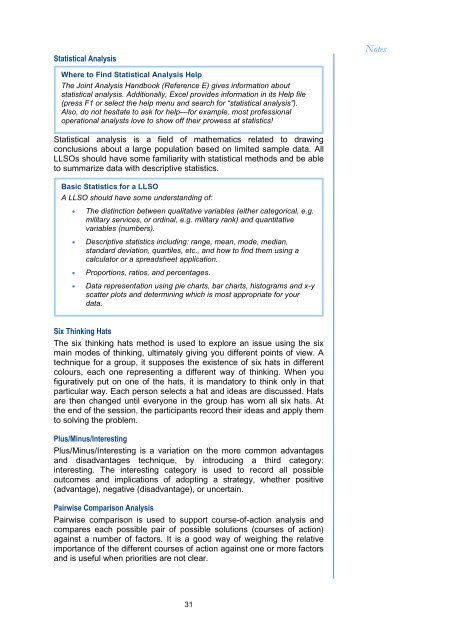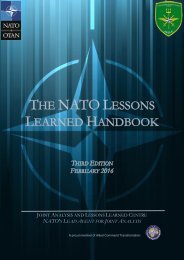JOINT ANALYSIS LESSONS LEARNED CENTRE NATO'S LEAD AGENT JOINT ANALYSIS
1ViofYb
1ViofYb
Create successful ePaper yourself
Turn your PDF publications into a flip-book with our unique Google optimized e-Paper software.
Statistical Analysis<br />
Notes<br />
Where to Find Statistical Analysis Help<br />
The Joint Analysis Handbook (Reference E) gives information about<br />
statistical analysis. Additionally, Excel provides information in its Help file<br />
(press F1 or select the help menu and search for “statistical analysis”).<br />
Also, do not hesitate to ask for help—for example, most professional<br />
operational analysts love to show off their prowess at statistics!<br />
Statistical analysis is a field of mathematics related to drawing<br />
conclusions about a large population based on limited sample data. All<br />
LLSOs should have some familiarity with statistical methods and be able<br />
to summarize data with descriptive statistics.<br />
Basic Statistics for a LLSO<br />
A LLSO should have some understanding of:<br />
<br />
<br />
<br />
<br />
The distinction between qualitative variables (either categorical, e.g.<br />
military services, or ordinal, e.g. military rank) and quantitative<br />
variables (numbers).<br />
Descriptive statistics including: range, mean, mode, median,<br />
standard deviation, quartiles, etc., and how to find them using a<br />
calculator or a spreadsheet application.<br />
Proportions, ratios, and percentages.<br />
Data representation using pie charts, bar charts, histograms and x-y<br />
scatter plots and determining which is most appropriate for your<br />
data.<br />
Six Thinking Hats<br />
The six thinking hats method is used to explore an issue using the six<br />
main modes of thinking, ultimately giving you different points of view. A<br />
technique for a group, it supposes the existence of six hats in different<br />
colours, each one representing a different way of thinking. When you<br />
figuratively put on one of the hats, it is mandatory to think only in that<br />
particular way. Each person selects a hat and ideas are discussed. Hats<br />
are then changed until everyone in the group has worn all six hats. At<br />
the end of the session, the participants record their ideas and apply them<br />
to solving the problem.<br />
Plus/Minus/Interesting<br />
Plus/Minus/Interesting is a variation on the more common advantages<br />
and disadvantages technique, by introducing a third category:<br />
interesting. The interesting category is used to record all possible<br />
outcomes and implications of adopting a strategy, whether positive<br />
(advantage), negative (disadvantage), or uncertain.<br />
Pairwise Comparison Analysis<br />
Pairwise comparison is used to support course-of-action analysis and<br />
compares each possible pair of possible solutions (courses of action)<br />
against a number of factors. It is a good way of weighing the relative<br />
importance of the different courses of action against one or more factors<br />
and is useful when priorities are not clear.<br />
31



